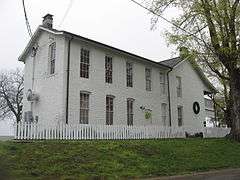Rose Hotel
|
Rose Hotel | |
|
Western side | |
  | |
| Location | S. Main St., Elizabethtown, Illinois |
|---|---|
| Coordinates | 37°26′43″N 88°18′16″W / 37.44528°N 88.30444°WCoordinates: 37°26′43″N 88°18′16″W / 37.44528°N 88.30444°W |
| Area | Less than 1 acre (0.40 ha) |
| Built | 1812 |
| Architect | James McFarlan |
| Architectural style | Georgian |
| NRHP Reference # | 72000461[1] |
| Added to NRHP | December 26, 1972 |
The Rose Hotel is a historic site owned by the U.S. state of Illinois. It is located in Elizabethtown, Illinois, on the banks of the Ohio River. The oldest wing of the hotel was built in 1812 by James McFarland. In 1813, he secured a license and files bond to assure legal and proper operation of his establishment. The license also set charges that McFarland might have charged.
- Breakfast, Dinner, and Supper - 25 cents
- Lodging - 12½ cents
- Oats or Corn per gallon - 12½ cents
- a half pint of whiskey - 12½ cents
- Small beer, one quart - 12½ cents
These price points reflect the currency regime of the very early United States; the new country had not yet minted a substantial amount of currency on its own account, and the United States dollar was more of a unit of account than an actual piece of money. The typical unit of money in actual use was the bit, equivalent to one Spanish real or 12½ U.S. cents.
In addition to sheltering travelers, early day taverns served as community centers and post office. The guests coming from distant brought news, and the local gentry gathered to hear. Men met to discuss questions of interest; some came for a few social drinks.
The earliest portion of the Rose Hotel was built in 1812; an east addition was constructed in 1848; and a rear addition in 1865. A sample room or display room was erected in 1891 at the rear of the hotel with just a passageway between the two buildings. Salesmen or drummers as they were commonly called displayed their wares to buyers who came to town. In 1882, shortly before his death, James Jr. built the summerhouse on the bluff in front of the hotel. The building of the two-story veranda was in 1866. The two-story building was constructed of brick supported on rubble sandstone basement walls and foundation.[2][3]
A tall and stately monument with the name and dates of the family stood in the hotel yard until the death of the last children: B.P. Cap-Mac or Uncle Cap as he was commonly called. At the time of his death the monument was moved, with the permission of Mrs. Rose, to the old cemetery on the hill in back of the First Methodist church. The Stone is said to mark the grave of B.P. McFarland, but neither his name nor dates appear there. The graves of the people named on the monuments are still in the hotel yard.
In 1891, Sarah Rose Baker, a widow woman who had worked at the hotel for 7 years, Mrs. Rose purchased the hotel from the McFarland family. The Rose Hotel passed to daughter Charlotte Rose Gullet upon Sarah Rose's death in 1939 and remained in the Gullet family, until the state of Illinois purchased the property in 1988, and then in 1999 thru 2000, a 1.6 million dollar restoration. The hotel was preserved and open again for business. The Rose Hotel is probably the last of a once noted line of River hotelries.
The hotel is currently leased by the Illinois Historic Preservation Agency to a private-sector operator, Sandy Vinyard, who maintains the structure as a bed and breakfast. The exterior is restored to its 1889 appearance.
Frontier taverns
The American frontier lacked an adequate infrastructure for the shelter and hospitality of travelers. Many states and territories, including Illinois, tried to deal with this problem by merging the right to sell whiskey by the drink with the duty to provide beds for travelers.
A frontier establishment that sold whiskey by the drink and provided lodging services was called a tavern. The oldest wing of the Rose Hotel was operated as a frontier Ohio River tavern in the 1830s. It is believed to have been built by James McFarland (1776-1837), and was known as the McFarland Tavern or McFarlan Tavern.
The Elizabethtown tavern was aimed at river flatboats and light cargo vessels passing up and down the Ohio River. Prior to the invention of the railroad, rivers like the Ohio were the primary routes for the transportation of mixed and package freight throughout the North American interior.
References
- ↑ National Park Service (2010-07-09). "National Register Information System". National Register of Historic Places. National Park Service.
- ↑ Farrar, William G. (March 8, 1971). "National Register of Historic Places Inventory - Nomination Form: Rose Hotel" (PDF). National Park Service. Retrieved December 7, 2013.
- ↑ "Rose Hotel". Illinois Historic Preservation Agency. Retrieved December 7, 2013.
